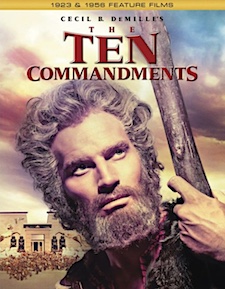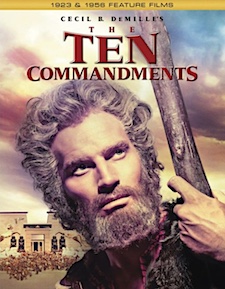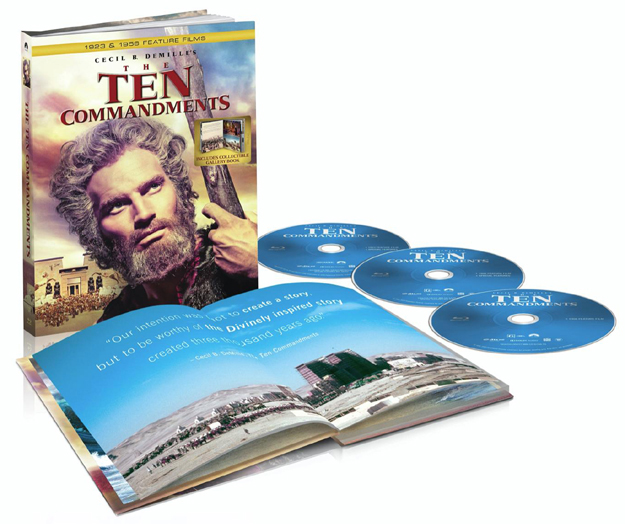Ten Commandments, The (Blu-ray Review)

Director
Cecile B. DeMilleRelease Date(s)
1923/1956 (March 10, 2020)Studio(s)
Paramount Pictures (Paramount Pictures Home Entertainment)- Film/Program Grade: See Below
- Video Grade: See Below
- Audio Grade: See Below
- Extras Grade: N/A
- Overall Grade: B
Review
[Editor’s Note: This review covers the new Digibook Blu-ray release, which is a repackaging of the early Limited Edition boxset release. Aside from the missing extra swag and DVDs, the disc-based content is the same. You'll find the full package pictured below.]
Cecil B. DeMille made The Ten Commandments twice, one as a silent film in 1923, and later as an all-star, Technicolor epic in 1956. The latter was the director’s last film in a long career that dated back to the very beginning of motion pictures. The two versions differ in structure. The silent version, a two-part parable, devotes only 45 minutes to ancient Egypt and Moses (Theodore Roberts). Most of the intertitles of this section are excerpts from the Old Testament. The balance of the 135-minute film takes place in the then-contemporary 1920s. A mother reads the Bible to her two sons, John (Richard Dix), a carpenter, and Dan (Rod La Rocque), a jazz-age kid who cynically claims that no one pays attention to the commandments anymore.
DeMille shows decadence in both sections of the ’23 version—the blaspheming, orgiastic revelry and worship of a false idol in the ancient section and Dan breaking all the commandments in his lust for wealth in the modern part. The ancient section lacks the splendor and production value of the later version. Moses is more a metaphor for goodness and hope than an actual man tasked by God to set free the Hebrew slaves of Egypt. In keeping with the style of silent film acting, Roberts strikes poses, makes grand gestures, and overreacts in order to convey emotion.
When DeMille remade The Ten Commandments in 1956, he abandoned the dual-story format and set the entire film in ancient times. Many actors were under consideration for the role of Moses, but Charlton Heston, a young up-and-coming actor, won the role.
Yul Brynner was cast as Rameses after DeMille saw him on Broadway in The King and I and was impressed by his charismatic presence. Brynner had to complete his commitment to the show before taking on the film role. Others in the cast include Anne Baxter (Nefritiri), Edward G. Robinson (Dathan), Yvonne De Carlo (Sephora), Debra Paget (Lilia), John Derek (Joshua), Cedric Hardwicke (Sethi), Nina Foch (Bithiah), Judith Anderson (Memnet), Vincent Price (Baka), John Carradine (Aaron), and Martha Scott (Yochabel).
Heston plays Moses as a human being rather than a revered religious icon, which makes the story relatable. Brynner is outstanding as Rameses. He looks great in the period costumes, projects a regal air, and turns in a solid performance. Anne Baxter’s portrayal seems at odds with the tone of the film. It’s been called campy, and some of her scenes do seem over the top, particularly when she’s lusting over Moses.
The film’s epic quality is its greatest attribute. DeMille’s care is evident in every scene, and reflects the massive logistical task of doing research, coordinating production in two countries, hiring a cast, and assembling thousands of extras.
For the ’23 version, DeMille shot the Egyptian sequences in California, but in ’56, he and his cast and crew filmed on an enormous set built in the Egyptian desert outside Luxor. We see this set during the exodus from Egypt and when Pharaoh’s chariots race after Moses to inflict vengeance for the death of the firstborn of Egypt.
Thousands of extras made up of Egyptian army soldiers and Cairo residents in period costumes provide tremendous production value. DeMille juxtaposes long shots with studio-filmed closer shots that portray intimate moments—a camel nibbling dates, a stubborn mule, carts filled with the elderly, a newly freed man bowing and praying, and sheep and goats being herded.
Loyal Griggs’ cinematography captures the scope of the exodus, often in high-angle crane shots and elaborate tracking shots. Elmer Bernstein’s triumphant music makes the exodus sequence an unforgettable highlight. The Mount Sinai scenes were also filmed in Egypt. Many of the sets and filming angles in the 1923 version are nearly duplicated in the later version.
Special effects are impressive in the 1923 film. The parting of the Red Sea was done by using a huge studio tank, flooding it with thousands of gallons of water and then running the film backwards to make it seem as if the water is magically parting. This same technique is used in the 1956 version. The obstacle that blocks Pharaoh’s chariots is a fiery wall, as opposed to the animated cyclone-like swirling cone in the later version.
Special effects in the ’56 version include Moses’ staff turning into a serpent, turning the sea blood-red, fiery hailstones, and a green cloud representing the plague that will claim the Egyptians’ firstborn. The burning bush from which God speaks to Moses (in Heston’s own voice) and the inscription of the commandments into stone tablets are accomplished with animation. Blue screen is used in scenes in which characters (in the studio) look out onto panoramic vistas of Egypt (shot on location).
The film credits for the 1956 film list the Holy Scriptures and other ancient and modern writings, including Prince of Egypt and Pillar of Fire, as the basis for the script, which fills in a missing 30-year period in Moses’ life. The script is often stilted in its dialogue and reflects an old-fashioned structure. Filming began in October 1954, after an extensive period of writing and rewriting, scouting locations, building sets, and designing costumes, hair, make-up, and jewelry. After shooting in Egypt, the company returned to Paramount to complete the film. In a number of scenes, studio-shot scenes are seamlessly blended with those filmed on location.
The 3-Disc Blu-ray Digibook release includes both 1923 and 1956 versions of the film. Bonus materials include an audio commentary; hand-tinted and 2-color Technicolor footage and a photo gallery from the 1923 film; the featurette The Ten Commandments: Making Miracles; a newsreel showing 1956 premiere in New York; 3 theatrical trailers for the ’56 version from 3 different decades; a photo gallery; and a booklet.
The 1956 version, featuring 1080p resolution, was originally presented theatrically in VistaVision in the 1.33:1 aspect ratio. This release features the widescreen aspect ratio of 1.78:1. As typical with Technicolor, colors are rich and vivid, and are especially notable in Pharaoh’s costumes, Nefertiti’s dresses and jewelry, and Moses’ red and white cloak. The fiery column, burning bush, and inscription of the ten commandments effects are done with animation and are not especially convincing. The exodus is truly epic, with location long shots blended with studio-filmed closer shots focusing on individuals. The plague that claims the lives of the Egyptian firstborn is depicted as an eerie green cloud that turns into what appear to be fingers reaching down to earth. Shadows over houses designate where death will fall. The idol-worship sequence uses the golden calf as its centerpiece, with lots of motion and activity to suggest more than is actually shown. Water being turned into blood is impressive. The 1923 version, also featuring 1080p resolution, is presented in the aspect ratio of 1.33:1.
The soundtrack for the 1956 version is English 5.1 DTS-High Definition Master Audio. Optional French, Portuguese, and Spanish soundtracks are available in Dolby Digital 2.0. Subtitles include French, Portuguese, Spanish, and English (for the hearing impaired). Dialogue is clear throughout. During the exodus, inserts of characters speaking personalize the fact that these people are now free. Chariots charging across the sands create a blend of racing horses’ hooves and chariot wheels. The Elmer Bernstein score adds excitement to the exodus scene, which DeMille felt was filmed too slowly. Bernstein’s score and a chorus also convey divine power during the burning bush scene. The sea parting involves roaring waters forming walls so that Moses and his followers can cross. The score is especially rousing in dramatic and epic scenes. In the 1923 version, the soundtrack is 2.0 Dolby Digital. The score for this version is played by Gaylord Carter at the Sargeant/Stark Wurlitzer Theater pipe organ. Optional subtitles in the ’23 version include French, Portuguese, and Spanish.
Audio Commentary – Katherine Orrison, author of Written in Stone: Making Cecil B. DeMille’s Epic The Ten Commandments, discusses the 1956 version. noting that many cast members were from DeMille’s silent days because he liked using actors he knew. The director “had to please many masters.” DeMille abandoned the modern story in the later version, keeping the action completely in ancient times. He created a pageant using Holy Scriptures and both introduced the film and served as its narrator. He was very much involved in doing publicity for the film. The heavy eye make-up used in ancient Egypt served as a repellent to keep flies away from the eyes to prevent blindness. DeMille felt this heavy makeup would not work with modern audiences. Edward G. Robinson was hired despite having been blacklisted, and credited DeMille with saving his career. Charlton Heston was cast largely because of his resemblance to the sculpture of Moses by Michelangelo. Anne Baxter is criticized for turning in a campy performance, but this might be due to the film’s old-fashioned storytelling. Once the 300-page script was complete, DeMille seldom made changes. Elmer Bernstein replaced Victor Young as composer when Young bowed out because of a full schedule. God speaking from the burning bush comes directly from the King James Bible. Heston’s voice was the voice of God. On TV viewings of the film, more people tune in to the second half of the film and it always wins in ratings. There is a description of some of the film’s special effects, including the green cloud that descends like a hand to claim the lives of Egypt’s firstborn. The set built in Egypt duplicated the original 1923 set, which was based on the Babylonian set built by D.W. Griffith for Intolerance. The exodus scene was filmed three times, using 8,000 extras. Various set-ups were drawn and then painted before filming as a guide to cinematographer Loyal Griggs. New chariots were built for the ’56 version because those from the silent picture were in poor condition. Members of the Egyptian cavalry corps drove the chariots. DeMille suffered a heart attack during filming of the exodus scene, and others on crew pitched in to ease the director’s work load. The revelry at the worshipping of the golden calf had to suggest, rather than show, debauchery. DeMille referred to the sequence as an “orgy for Sunday school children.”
The Ten Commandments: Making Miracles – DeMille notes that the ’56 version would long outlive him. Fraser Heston, son of Charlton Heston, and Cecilia DeMille Presley, granddaughter of DeMille, offer comments about the production. DeMille felt the second half of the ’23 version didn’t work and decided to set the ’56 version entirely in the ancient period. Paramount was nervous because there was no budget and a costly foreign location was involved. DeMille’s The Greatest Show on Earth had won the Best Picture Academy Award in 1952. Source materials for The Ten Commandments dated from 500 to 1,000 years after the events in the film. Many researchers worked on the film. Henry Wilcoxon, who had appeared in many of DeMille’s films, was in the cast and also served as DeMille’s right hand. Many actors were up for the role of Moses. Grace Kelly and Audrey Hepburn were considered for the role of Nefertiti, but Anne Baxter eventually got the part. Moses is revered in three religions. The Egyptian location was massive, with accommodations for feeding extras and horses. Fraser Heston played the baby Moses. For the scene of Moses and his followers walking through the parted sea, a wall separating two sound stages was removed to accommodate the extreme long shot. Specific dresses and pieces of jewelry created for the film are shown. The Ten Commandments was the highest-grossing motion picture of 1956.
1923 Color Sequences – Two early techniques of color used in the exodus and parting of the Red Sea are included. The Handschiegel method, preferred by DeMille at the time, involved hand-tinting of specific scenes. The 2-color Technicolor process, precursor of 3-strip Technicolor, is not full-spectrum and favors reds.
Trailers – Three trailers are included. The original 1956 trailer is the most elaborate and features Cecil B. DeMille discussing the source material for the film. He refers to a copy of the Michelangelo sculpture of Moses, a huge Bible, and several sketches as he discusses the process of planning and making the film. A few scenes are shown. The later trailers, from 1966 and 1989, are more traditional. They depict fleeting glimpses of exciting scenes. The 1989 trailer is the only one that shows the parting of the Red Sea clearly.
Booklet – A 16-page booklet contains several color photos from the ’56 film, a shot of the huge desert set constructed for this film, and an overview of its production. Eight close-ups of key cast members in character costume and make-up are included.
1923 VERSION (FILM/VIDEO/AUDIO/EXTRAS): C/C+/B-/C+
1956 VERSION (FILM/VIDEO/AUDIO/EXTRAS): B-/A/A/A
– Dennis Seuling


